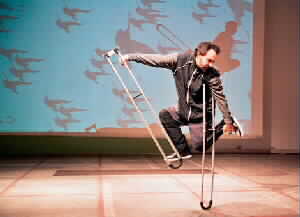Adventures in Dance Part III: Kickstart

I followed up these two voyages into excellence with a rude awakening, something of a descent into disappointment and even irritation when I went to see VIDF’s presentation of Kickstart, a series that features artists with various mobility issues. The first piece, Geometry of the Circle choreographed by Peggy Baker, featured dancer Alison Denham along with Mark Brose, a Toronto-based musician who has MS and gets around in a wheelchair. Throughout the piece, Brose’s abstract vocalizations were mingled with Denham’s graceful dancing as the two engaged in a duet that explored the creativity that can emerge from a relationship. This creative piece seemed to be, at least in part, a quirky love story that took two very different types of art and merged them into a dialogue that was at times comical and at times filled with longing. While these themes and emotions emerged clearly from the piece, I simply did not experience this piece as a very cohesive one.
I found it hard to “get” the rapport between the two artists and although Denham is a beautiful dancer to watch, and Brose’s vocalizations were very expressive, the two seemed distant from each other, and neither the choreography nor the creative voice of Brose bridged this gap, up until the very end when they did come together in a moment of lovely emotional catharsis. However, while this last bit was quite convincing, I did not find enough either artistically or emotionally to bring me into this pair’s world for most of the piece, and it left me feeling as though it was an unfinished idea in the making.
If Geometry of the Circle was a bit disappointing, the piece that followed, Bill Shannon’s excessively long Spatial Theory was outright irritating. Shannon, who gets around on a pair of custom-designed crutches, is a creative and excellent dancer who fuses hip hop, house, silent film acting and skateboard culture to create a unique brand of street dance that proves, without question, that his crutches -- which he describes as an extension of his body -- add to both his inventiveness and agility. So, obviously, it’s not his dancing that was the problem. Shannon’s dancing is great, it’s creative, it’s virtuosic, but to get to see him dance, one has to endure a very long and, at times abusive diatribe about performance, dis/ability, and (of all things), he kept talking about phenomenology. He loves that word.
So, while Shannon’s dancing was great, it took up only half the show. Maybe. The rest of it was an acerbic and disorganized rant about what it’s like to be him. Perhaps most offensive and annoying was Shannon’s tendency to make fun of his audience, taking a heavy-handed and pretentious tone, while deriding those who are asking themselves “when is this guy gonna stop talking and dance?”. Evidently, I was one of those people, and by time Shannon bothered to dance, I was feeling predisposed to find fault because of his imperious and pretentious way of projecting onto his audience what he thinks (or knows!) that they are perceiving of him. He talked at length, and in some faux-street style about how people see him. You know, phenomenology. Accusing his audience in general and in particular of seeing only his disability. He even showed a sort of unconvincing video to illustrate his point. He also showed a video of himself skateboarding, and I would have loved to really see it, but the white screen was only pulled down half way, so that half of the video was projected against a brick wall, rendering it hard to decipher. While this was going on, Shannon informed his audience, with no small amount of sneering that “You only get to see half”. Is this also phenomenology? It came across as puerile. Equally mystifying, if slightly less abrasive was the long segment of this show that had a live video feed that showed the live DJ (DJ Excess) doing his mixing. Okay, if I were at another show, say some house music show and wanted to see a DJ do his scratch and mix routine, this would have been cool. But this too felt self-indulgent and designed to aggravate.
So, Shannon is a great dancer with his own pretentious genre of childish, cheeky, and even somewhat hostile arrogance. He loves to tell his audience that he knows how they view him, and he’ll mock your thoughts before you even know what they are. I can’t help wondering if he wants us to think exactly that which he thinks (knows) we think so that he can justify his strange hostility and sulkiness. The truth is that the dance part of Shannon’s act is so good, that if he would just stop talking and dance, no one would, for a moment, project any kind of assumptions about abilities onto him. But then we couldn’t dissect - say it one more time - phenomenology for an hour.



